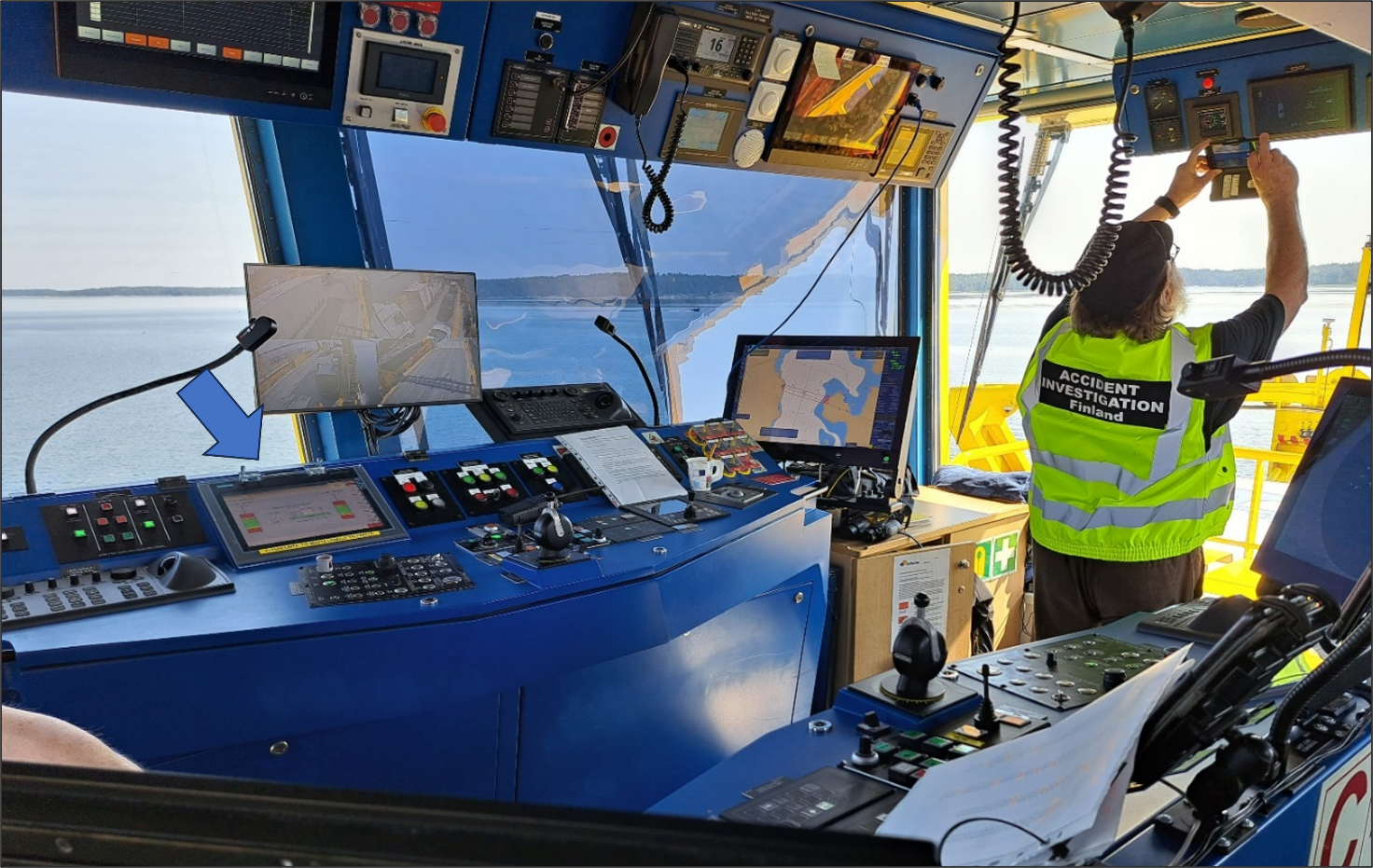M2023-01 Collision of the L-317 cable ferry with a quay in Korpo on 13 April 2023
The L-317 road ferry (cable ferry), which operates between Pärnäs on the island of Nagu and Retais on the island of Korpo, collided with the apron in Retais at approximately 9.45 pm on 13 April 2023 as a result of a sudden loss of steerability. The loss of steerability, which was discovered just before the apron in Retais, was caused by the switching of the ferry’s propulsion control system to manual. This, in turn, was the result of a mobile phone pressing against the resistive touchscreen of the propulsion control system. The captain of the ferry failed to correctly diagnose the issue and instead interpreted it as a fault in the ferry’s electricity supply. The captain was unable to restore steerability, as a result of which the ferry collided with the apron approximately 40 seconds after the propulsion control system had switched to manual and shortly after also with the quay of the marina that was located next to the apron. The collision caused superficial damage along the side of the ferry and physical damage to the apron as well as the quay and buoys of the marina. The ferry was not carrying any passengers or cars at the time of the incident. Steerability was restored after the incident, and the ferry travelled to Pärnäs on its own power, where the investigation into the causes of the incident continued. The ferry was returned to service five days later.
The Finnish Act on the Transport System and Highways defines cable ferries as extensions of the road. In the context of the enforcement of the Finnish Ship Safety Control Act, however, cable ferries are classed as ‘other ships’. This means that the responsibilities related to ensuring the technical safety and safe operation of cable ferries as well as overseeing crews and the associated training and qualifications are split between the Finnish Transport and Communications Agency, the competent Centre for Economic Development, Transport and the Environment and service providers.
A modern ‘other ship’ such as the L-317 with its sophisticated systems and software differs significantly from vessels that cable ferry captains were previously used to operating. For most captains, operating the L-317 marked their first encounter with automated systems. Cable ferry captains are not subject to special seafarers’ qualifications, and instead ensuring their competence is the service provider’s responsibility.

The competence and educational background of cable ferry captains vary considerably. Ferry transport operators are free to set their own competence requirements for cable ferry captains, within the confines of the universal eligibility criteria laid down in the Act on the Transport System and Highways. It may not always be possible to incorporate the operating principles of complex systems into the orientation training organised by the service provider to the extent required to ensure smooth and confident use of the systems in all circumstances and conditions. This is especially significant from the perspective of the wide variety of vessels operated at different ferry crossings and the special characteristics of this particular ferry crossing, which all have a bearing on the overall safety and smoothness of traffic.
The Korpo ferry crossing was previously operated by commuter ferries. Switching to a more cost-effective cable ferry had been discussed for decades, however. The switch was made possible by the Finnish Transport and Communications Agency’s ‘Virtual Cable Regulation’ of 2022, and the L-317, which was completed in early 2023, started operating at the crossing in March 2023. The L-317 was built to be larger than usual in order to increase transport capacity on this route. The L-317 was designed using tried and tested solutions and lessons learned from the commuter ferries Altera and Elektra, which operate on the Pargas–Nagu commuter ferry route. These solutions and experiences led to a focus on increasing automation, while differences between the crews and the competence requirements of crews on board commuter ferries on the one hand and road ferries (cable ferries) on the other were given less attention.
The responsibilities relating to operating and overseeing cable ferry transport are split between multiple organisations. The Southwest Finland Centre for Economic Development, Transport and the Environment has ended up being both the client and the body overseeing the standard of service and safety. The Centre for Economic Development, Transport and the Environment also makes decisions on the crews of cable ferries, despite not necessarily having the requisite competence in maritime safety. The government agency in charge of coordinating shipping (the Finnish Transport and Communications Agency) is responsible for ensuring the technical safety and safe operation of cable ferries, which responsibility it mostly discharges by carrying out inspections. This leaves the transport service provider with a considerable amount of the responsibility for ensuring the overall safety and smoothness of transport at the various ferry crossings as well as the responsibility for maintaining the diverse fleet of passenger and vehicle ferries. In order to make the division of responsibilities clearer and to improve safety in general, the Safety Investigation Authority wishes to call the attention of the organisations that contribute to the provision of cable ferry transport to the safety challenges posed by new technology and different kinds of ferry crossings in particular.
The Safety Investigation Authority recommends that:
• The Ministry of Transport and Communications engage with the Finnish Transport and Communications Agency, the Southwest Finland Centre for Economic Development, Transport and the Environment and cable ferry transport operators in a dialogue aimed at reforming the laws governing cable ferry transport.
• Finferries update its training programme to better factor in each cable ferry crossing and the characteristics of the ferry or ferries operated on that route.
Published 12.4.2024
